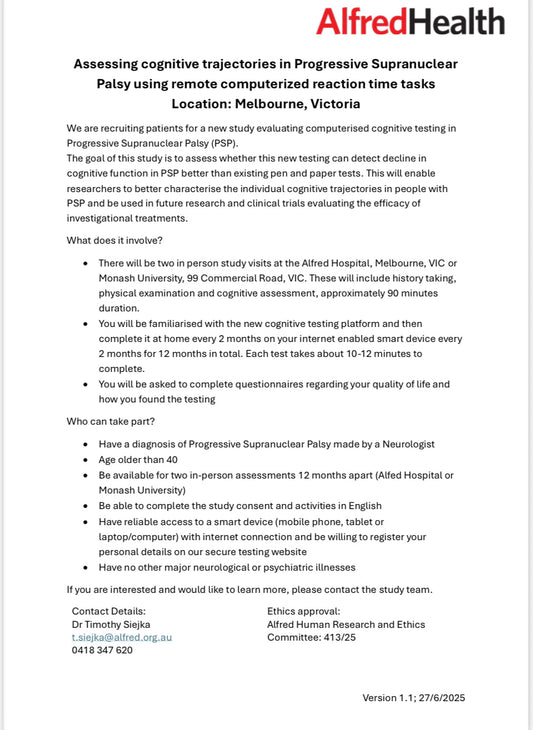Progressive Supranuclear Palsy (PSP) is a rare neurodegenerative disease that affects movement, balance, and cognition. Often mistaken for Parkinson’s disease due to similar early symptoms, PSP progresses more rapidly and has distinct features that set it apart. This article provides an overview of PSP, its symptoms, and practical tips for managing the condition.
Quick Facts About PSP
- PSP is classified as a tauopathy, meaning it’s caused by the accumulation of abnormal tau protein in the brain [1].
- It affects approximately 6 out of every 100,000 people worldwide, making it a rare condition [2].
- The average age of onset is around 63, and it rarely occurs before age 40 [3].
- Unlike Parkinson’s, PSP does not typically respond well to levodopa, a common Parkinson’s medication [4].
- Life expectancy after diagnosis is typically 6 to 12 years, though this varies by individual [5].
Common Symptoms of PSP
PSP symptoms can vary, but they generally worsen over time. Here are the most notable signs:
- Eye Movement Problems: Difficulty moving the eyes vertically (up and down), leading to blurred vision or trouble focusing. This is a hallmark symptom and often one of the earliest signs [6].
- Balance and Mobility Issues: Frequent falls, especially backward, due to impaired balance and coordination [7].
- Stiffness and Slowness: Muscle rigidity and slowed movements, similar to Parkinson’s, but often more pronounced in the neck and trunk [8].
- Speech and Swallowing Difficulties: Slurred speech and trouble swallowing (dysphagia), which can increase the risk of choking [9].
- Cognitive and Emotional Changes: Memory problems, apathy, depression, or sudden emotional outbursts, such as inappropriate laughter or crying [10].
Tips for Managing PSP
While there is no cure for PSP, certain strategies can improve quality of life for patients and caregivers:
- Work with Specialists: Consult a neurologist familiar with PSP for accurate diagnosis and management. Physical and occupational therapists can help with mobility and daily tasks.
- Adapt the Environment: Remove tripping hazards like rugs, install grab bars, and use a walker or wheelchair to prevent falls.
- Eye Care Strategies: Use prism glasses or work with an eye specialist to manage vision difficulties. Reading or watching TV may require tilting the head or materials.
- Speech and Swallowing Support: Speech therapists can teach techniques to improve communication and safe swallowing. Soft foods or thickened liquids may reduce choking risks.
- Emotional Well-Being: Support groups for patients and caregivers can address emotional challenges. Antidepressants or counseling may help with mood changes.
Progressive Supranuclear Palsy is a challenging condition, but understanding its symptoms and implementing practical strategies can make a difference. Early recognition of its unique features—like eye movement issues and backward falls—can lead to better care. If you or a loved one suspect PSP, seek medical advice promptly to tailor a management plan.
Sources
- National Institute of Neurological Disorders and Stroke (NINDS) - PSP Fact Sheet
- CurePSP - Prevalence of PSP
- Mayo Clinic - Progressive Supranuclear Palsy Overview
- Parkinson’s Foundation - PSP vs. Parkinson’s Disease
- American Academy of Neurology - PSP Prognosis
- Johns Hopkins Medicine - PSP Symptoms
- National Organization for Rare Disorders (NORD) - PSP
- Movement Disorders Society - PSP Clinical Features
- Cleveland Clinic - PSP Management
- Alzheimer’s Association - PSP Cognitive Symptoms
Disclaimer
The information provided in this article is intended for educational and informational purposes only. It is not a substitute for professional medical advice, diagnosis, or treatment. The facts, symptoms, and tips presented are based on general knowledge and reputable sources available as of the posting date. They may not reflect the latest research or individual variations in disease presentation and progression.
Every person’s experience with these conditions is unique. Symptoms, outcomes, and management strategies may differ. Always consult a qualified healthcare professional, such as a neurologist or specialist, for personalized guidance tailored to your specific situation. The sources cited aim to ensure transparency and credibility; however, websites and their content may change over time, and accessibility is not guaranteed.
The author and publisher of this article are not liable for any errors, omissions, or consequences arising from the use of this information. Reliance on this content is at your own risk. If you suspect you or a loved one may have one of these conditions, seek prompt medical evaluation from a licensed provider.


 Donate
Donate



